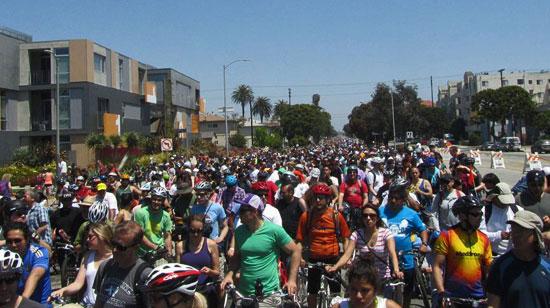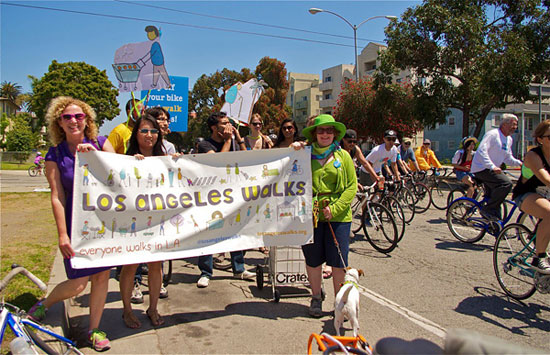Finding foot room at CicLAvia
June 6, 2013
Deborah Murphy’s first experience with CicLAvia was no smooth ride. She was walking her Jack Russell terrier down the sidewalk in East Hollywood when she decided to make a move to the car-free streets.
“Get out of the road with your dog, lady—this is for cyclists, stay off the street,” she remembers someone yelling.
When the next CicLAvia brought more shout-downs, the long-time pedestrian advocate and founder of Los Angeles Walks decided to form WalkLAvia, a group aimed at staking pedestrians’ claim to a share of the roads during the events.
“This is an open streets event and people should be out there walking or on bikes or doing cartwheels or whatever they want to do,” Murphy said.
No one would love to see that more than CicLAvia’s organizers, who’ve been pushing for that kind of inclusivity from the beginning. To make that point abundantly clear, they’re billing the upcoming
June 23 event along Wilshire Boulevard’s “Miracle Mile” as “the most walkable CicLAvia ever!”
“This all feeds into the ultimate purpose of CicLAvia—to connect people with their community in a way that is not possible in a car,” said CicLAvia spokesman Robert Gard. “On bike and, more specifically, on foot, you are really able to interact with your fellow Angelenos.”
But turning that long-held aspiration into a reality has proven increasingly elusive as the event’s popularity has grown. The last event, which opened a 15-mile stretch of streets from downtown to Venice Beach, drew a crowd of about 180,000 people, according to Gard. The overwhelming majority of them were on bikes. “There are so many bicyclists now, walking appears to not be part of it,” Gard said.
Unlike the last route, however, the new one along Wilshire Boulevard will be just 6 miles, with pedestrian-only zones at each end. Although architecture tours and other walker-friendly activities are planned, organizers think the location itself may lure more walkers. The Wilshire route will offer more street life and more sights—from MacArthur Park to Koreatown to “Miracle Mile,” with its museums and vibrant arts scene.
Of course, any event with “cycle” in its name is bound to attract a bike-heavy crowd. But part of the challenge is simple growing pains, Gard said. CicLAvia was inspired by ciclovías in Bogotá, Colombia, which began in the mid-1970s. L.A.’s first event was held just three years ago, and local cyclists jumped at the chance to freely ride streets, where automobile traffic normally makes biking nerve-wracking, even perilous.
Once people realize CicLAvia events are here to stay, bike riders won’t jump at the chance to ride every one of them for fear they’re missing a once-in-a-lifetime opportunity. “In talking with our peers in Central and South America, once they were more established, people understood it better,” Gard said. In time, serious bicyclists came to accept that ciclovías were for riders of all ability levels—and for pedestrians, too.
Alissa Walker, a member of Los Angeles Walks’ steering committee, said attitudes have already started to change.
“It has gotten a lot better,” Walker said. “At first, people didn’t understand that it wasn’t a race or something. It was possibly dangerous.”
CicLAvia organizers, in hoping to encourage that evolution, highlighted the problem using a video of a disabled man describing how he was verbally abused and directed off the streets because he was on a special, motorized device to accommodate his disability.
The City of Los Angeles’ first-ever pedestrian coordinator, Margot Ocañas, has participated in all six CicLAvias—sometimes on foot, sometimes on bike. She believes that continued, heavy interest from cyclists will mean that the roads “below the curb” will probably remain dominated by bikes, while pedestrians will take the sidewalks. For safety’s sake, she said, that’s not necessarily a bad thing.
Creating more pedestrian-only areas could help bring out more walkers, Ocañas said. She also envisions using the main route as a “launch pad for walking activities that tentacle off into other areas.”
No matter how CicLAvia evolves, everyone agrees that it should keep on rolling, stepping and hula-hooping.
“The fact that the bikes and pedestrians are having that conversation,” Ocañas said, “I’ll take it any day over bikers or pedestrians having that conversation with a car.”

There were so many cyclists at April's event that they became walkers, like on this stretch of Venice Boulevard.
Posted 6/6/13













 405 bridge work causes a stink
405 bridge work causes a stink

